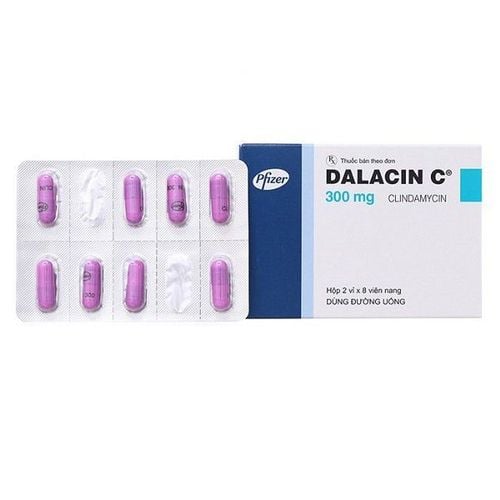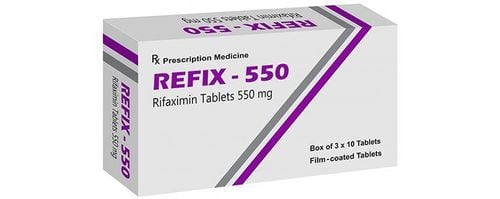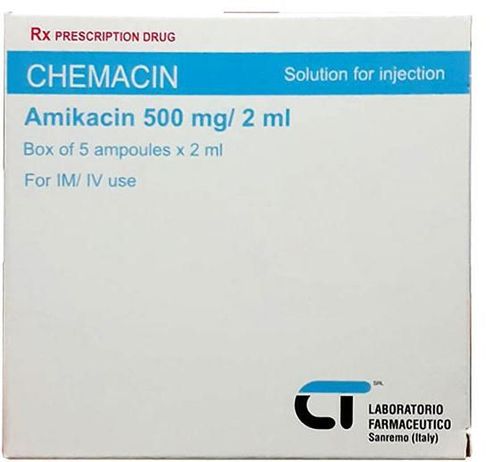This is an automatically translated article.
Pybactam contains 2 main ingredients: Piperacillin 4g and Tazobactam 0.5g. These are two broad-spectrum antibiotics, combined to achieve high efficiency in the treatment of severe infections in the lower respiratory tract, urinary tract, abdomen, blood skin in adults and intra-abdominal and pouch infections. bile in young children.
1. What does Pybactam do?
Pybactam has 2 ingredients: piperacillin 4g (as piperacillin sodium) and tazobactam 0.5g (as tazobactam sodium). This is a white or almost white powder for solution for infusion in a glass vial.
Piperacillin belongs to the group of broad-spectrum penicillin antibiotics, which can kill many types of bacteria. Tazobactam can prevent some strains of bacteria that are resistant to piperacillin. This means that the combination of piperacillin and tazobactam kills more bacteria.
Pybactam is used to treat certain infections of the lower respiratory tract (lungs), urinary tract (kidneys and bladder), abdomen, skin, and blood in adults and adolescents. It can also be used to treat infections in patients with low white blood cell counts (decreased ability to fight infections).
For children 2-12 years of age, Pybactam is used to treat infections in the abdomen such as appendicitis, peritonitis (infection of the fluid and membranes surrounding the organs in the abdomen) and infections of the pouches. secret . And as with adults, it can also be used to treat bacterial infections in children with low white blood cell counts (decreased ability to fight infections). In some severe infections, your doctor may consider combining Pybactam with other antibiotics.
2. Dosage and usage
Pybactam is administered by intravenous drip for 30 minutes. Dosage varies depending on the type of infection, age, and kidney function. Reference dose is as follows:
Adults and adolescents 12 years of age and older:
The usual dose is 4g/0.5g piperacillin/Tazobactam intravenous infusion, every 6-8 hours. Children 2-12 years old:
The usual dose for children with abdominal infections is 100 mg/12.5 mg/kg body weight, intravenously every 8 hours. The usual dose for children with low white blood cell counts is 80mg/10mg/kg body weight, intravenously every 6 hours. Dosage will be calculated according to the child's weight, but should not exceed 4g/0.5g piperacillin/tazobactam. Pybactam will be used until symptoms of infection have completely disappeared, an average of about 5-14 days.
People with kidney failure:
Need to reduce the dose or increase the interval between doses, combined with regular blood tests are things the doctor can do during the use of Pybactam. Especially when long-term to ensure minimal side effects.
3. Contraindications
Pybactam is contraindicated in people who are allergic to piperacillin, Tazobactam or any other ingredient of the drug. In addition, the drug is also contraindicated in people who are allergic to penicillins, cephalosporins, betalactamase inhibitors and Pybactam.
4. Side effects
Although not all people taking Pybactam experience side effects, some people may. Contact your doctor immediately if you see:
Serious side effects of Pybactam include:
Severe rash (Stevens-Johnson syndrome, bullous dermatitis and toxic epidermolysis); Swelling of the face, lips, and tongue or other areas of the body; Shortness of breath, wheezing, or shortness of breath; Severe rash or thickening of the eyebrows; Yellowing of the face or skin; Severe blood cell damage and leukopenia; Severe or persistent diarrhea , accompanied by fever or weakness Common side effects of Pybactam include:
Fungal infections; Diarrhea; Decreased platelets and red blood cells; Prolonged clotting time, causing false test results (positive with Coomb's test). direct); Decrease in blood protein; Headache and insomnia; Abdominal pain, vomiting, nausea, constipation and indigestion; Increased liver enzyme activity in the blood; Abnormal blood test results reflecting kidney function; Fever and injection site reactions Less common side effects of Pybactam include:
Decreased white blood cell count; Hypokalemia; Decreased blood glucose; Low blood pressure; Phlebitis and redness of the skin; Hyperbilirubinemia; Pain muscles and joints, chills. Rare side effects of Pybactam include:
Inflammation of the oral mucosa. Unspecified side effects of Pybactam include:
Thrombocytopenia; Hepatitis; CKD; Kidney disease. If you experience these symptoms, the patient should stop using Pybactam and notify the doctor for appropriate treatment.
5. Drug interactions
Some possible drug interactions when used with Pybactam include:
The gout medicine (probenecid) because it increases the time it takes to clear piperacillin and tazobactam from the body. Anticoagulants (such as heparin, warfarin, or aspirin). Muscle relaxants used in surgery. If combined, it is necessary to inform the doctor before general anesthesia. Methotrexate (medicine for cancer, arthritis, or psoriasis) because it can increase the time it takes to clear methotrexate from the body. Medicines that lower blood potassium levels (diuretics and some cancer drugs). Other antibiotics such as tobaramycin or gentamycin.
6. Overdose and treatment
Overdosage of Pybactam can cause nausea, vomiting, diarrhea, increased neuromuscular excitability or convulsions if used in high doses intravenously, especially in patients with renal failure. If an overdose is suspected, the drug should be discontinued and the doctor immediately informed for timely adjustment.
7. Caution
Some notes before starting treatment with Pybactam include:
If you have a history of allergies, are having diarrhea, you must fully inform your doctor. People who have low potassium levels, have liver or kidney problems, or are on hemodialysis will have their kidney function checked before starting Pybactam and need regular blood tests during treatment. If you are taking certain medications (anticoagulants) for the prevention of blood clots or if any unexpected bleeding occurs during treatment with Pybactam, notify your doctor immediately. If a convulsion occurs during treatment with Pybactam or a new infection is suspected or a previous infection becomes worse, the drug should be discontinued and the doctor informed for prompt management. Pybactam is not recommended for use in children under 2 years of age due to insufficient data regarding safety and efficacy. Pybactam is able to penetrate into the fetal circulation and breast milk. Therefore, caution should be exercised when using this drug for this patient. Pybactam contains 217mg of sodium, so it is important to follow a salt-restricted diet while taking this medicine. Above is all information about Pybactam, patients need to carefully read the instructions for use, consult a doctor / pharmacist before using. Absolutely do not arbitrarily buy Pybactam drugs to treat at home because there may be unwanted side effects.
Please dial HOTLINE for more information or register for an appointment HERE. Download MyVinmec app to make appointments faster and to manage your bookings easily.













